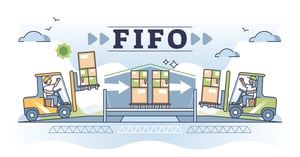The efficacy of your inventory management strategy can make or break your success. It’s that simple. How you elect to organize, stock, and track your inventory can profoundly affect everything from your profitability to your customer experience to your supply chain efficiency. First in, first out (FIFO) is a simple yet effective method of valuing and exercising control over your business’s inventory. Let’s take a dive into all things FIFO and explore how your business can leverage this system to scale and drive long-term, sustainable success.
What Is FIFO, and How Does It Work?
FIFO, or the first in, first out method, is an inventory management practice wherein the first items to enter inventory are the first ones rotated out for order fulfillment and shipping. This ensures product quality and integrity are preserved, prevents revenue loss due to expired goods, and provides consumers with the freshest stock possible.
Market volatility and economic fluctuations can cause the cost of producing goods to increase over time. By utilizing the FIFO method, businesses can capitalize on lower-cost goods and optimize profit margins by ensuring older products are moved and sold before expiring or becoming obsolete.
To illustrate how this method is used in everyday life, let’s look at a grocery store. Supermarkets regularly purchase cases of milk to keep shelves stocked. As shoppers purchase the milk, workers behind the scenes are tasked with pushing older cartons to the front and placing the newer milk behind them. This ensures that cartons with earlier expiration dates are sold first.
By implementing a FIFO system, businesses can reap a myriad of benefits, including decreased costs by avoiding overstocking and enhanced customer satisfaction. Additionally, FIFO greatly improves inventory visibility, allowing businesses to identify discrepancies, quickly adjust stock levels, and ensure operations remain organized and efficient.
How FIFO Can Optimize Inventory Management
There are a multitude of advantages to using FIFO for inventory management. One of the biggest benefits is in its ability to greatly reduce costs. How? By ensuring stock adequately aligns with demand. Without this system in place, businesses run the risk of overstocking and having to discard older stock down the line—a.k.a. throw money out the window.
FIFO can also improve the customer experience, strengthening loyalty and repeat business, by providing buyers with fresh, working, undamaged products. It’s an efficient and effective system that furnishes brands with greater control over their inventory, reducing costs and ensuring operations run as smoothly as possible.
So, why should your business consider implementing a FIFO system? Here’s a quick recap:
- To reduce costs
- To enhance the customer experience and drive loyalty
- To prevent waste and revenue loss due to outdated or expired products
- To improve efficiency across the supply chain
- To increase accuracy and track product ages
Streamlining Inventory Management: How To Introduce FIFO for Your Business
You’re ready to improve your bottom line and increase efficiency, now what? To successfully implement a FIFO system, you should first devise a detailed list of all available products, including their manufacturing and expiration dates. By doing so, you’ll be armed with the information needed to determine which goods must be sold and shipped first. Next, inventory will need to be stored and organized in a manner that places products in order based on age—allowing merchandise to be rotated in and out in a timely and efficient way.
When implementing FIFO, it’s integral to have a system in place for tracking and recording inventory activities in real-time. Maintaining accurate inventory figures is vital for an efficient supply chain—from creating a positive customer experience in today’s competitive marketplace to complying with SEC regulations. Stock that is missing or unaccounted for will have a direct and negative impact on your profitability.
Having intuitive and technology-driven inventory management software to facilitate processes and track goods is not only valuable for visibility purposes, but it can also provide actionable insights to make business improvements. Through automation, for instance, you can identify low-performing items, receive notifications to reorder products when stock is low, and ensure inventory is housed in locations closest to your end customer. Where products are housed in key markets close to your customer, it can reduce shipping times (a must among today’s consumers) and decrease last-mile delivery costs.
Businesses that approach inventory management thoughtfully and strategically can maximize all the benefits the FIFO system has to offer. To properly implement a FIFO system, consider the following steps:
- Establish well-defined goals and objectives for FIFO-based inventory control and management.
- Embrace automation by leveraging barcode or RFID technology.
- Develop a system for tracking, recording, and analyzing inventory data to ensure efficiency and identify opportunities for improvements.
- Create buy-in among staff to ensure the FIFO system is fully adopted and set up for success.
Improve Your Inventory Management, The SMART Way
Tracking and managing your inventory is a crucial piece of ensuring your business thrives. A FIFO system can help your brand increase efficiency, reduce waste and revenue loss, create a strong customer experience, and remain organized. The best way to drive your success? Having the expertise and proven systems of a 3PL partner on your side.
At Smart Warehousing, we provide brands just like yours with cutting-edge inventory management technology and comprehensive logistics solutions to move your business forward. We can craft personalized solutions to support your business’s needs, from warehousing and order fulfillment to shipping and return management. To learn more about our technology, solutions, and what Smart Warehousing can do for you, contact our team today.


